Smerinthus saliceti
Smerinthus saliceti
Boisduval [1875]
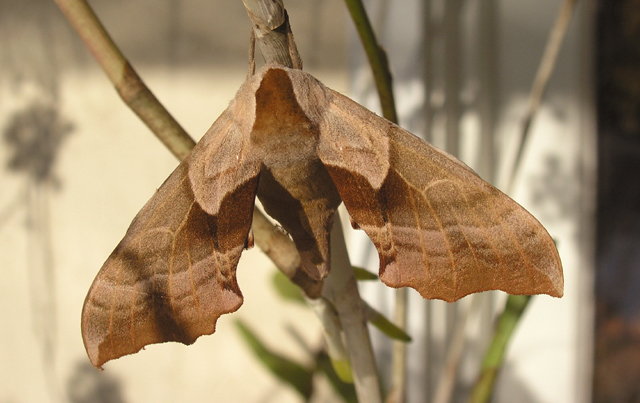
Smerinthus saliceti, Encinitas, northern/coastal San Diego County, California,
August 21, 2007, 5:00pm, courtesy of Don Doerfler, Digital Camera: Olympus 5060, 8MP
This site has been created by
Bill Oehlke at oehlkew@islandtelecom.com
Comments, suggestions and/or additional information are welcomed by Bill.
| TAXONOMY:
Superfamily: Sphingoidea, Dyar, 1902
Family: Sphingidae, Latreille, 1802
Subfamily: Sphinginae, Latreille, 1802
Tribe: Smerinthini, Grote & Robinson, 1865
Genus: Smerinthus, Latreille, 1802
Species: saliceti, Boisduval [1875] |
DISTRIBUTION:
The Salicet sphinx, Smerinthus saliceti
(wing span: 2 5/8 - 3 1/2 inches (6.7 - 8.9 cm)), flies in valleys and along streamsides from Mexico City north to west
Texas, New Mexico, southern Arizona, and extreme southern California.
The forewing outer margin is wavy and the upperside of forewing is gray-brown with distinct dark and light bands.
The upperside of the hindwing is mostly red with a yellow-tan outer margin and a blue spot which is usually divided by
a V-shaped black line.
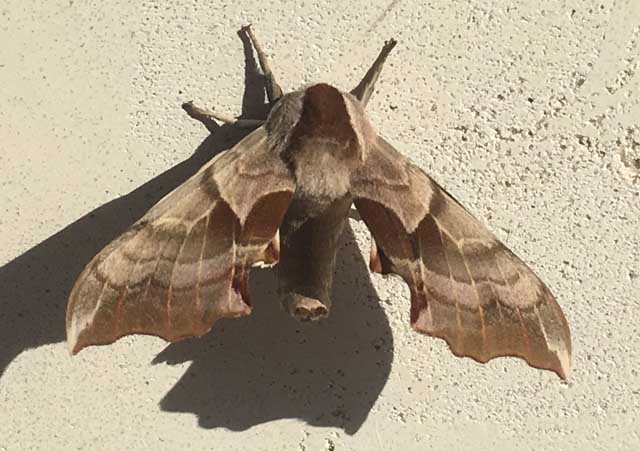
Smerinthus saliceti, San Clemente, Orange County, California,
September 4, 2016, courtesy of Monika Burke.
CATE indicates this species is more orangey-brown than the very similar grey to grey brown Smerinthus cerisyi from further north and east.
The hindwing eyspot is also somewhat different. In Smerinthus cerisyi, the hindwing dorsal eyespot has the black mark in the centre of the
blue area circular or diamond shaped and completely surrounded by blue, whereas in Smerinthus saliceti the blue spot is divided by a downwardly angulate
band that touches the lateral, black borders.
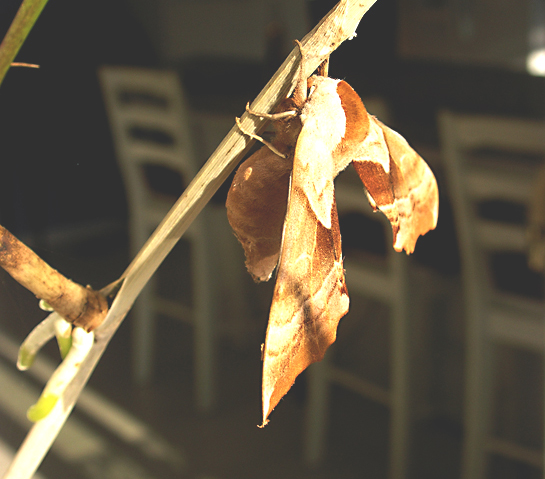
Smerinthus saliceti, Encinitas, northern/coastal San Diego County, California,
August 21, 2007, 5:00pm, courtesy of Don Doerfler, Digital Camera: Olympus 5060, 8MP
Don writes, "I'm just blocks away from a large lagoon and wetland open space preserve- San Elijo Lagoon. I also have a sub-tropical landscaped back yard with pool.
These pictures were taken just outside my back door, the moth is hanging on my huge Epidendren orchids (which are native to Mexico as well)."
I suspect the wetland habitat has willows and/or poplars, the larval hosts of this species.
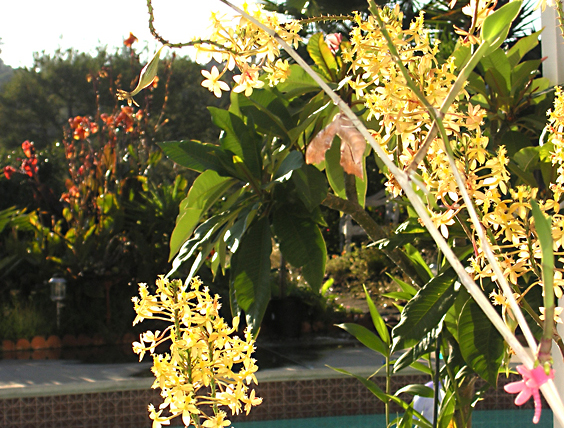
Smerinthus saliceti, Encinitas, northern/coastal San Diego County, California,
August 21, 2007, 5:00pm, courtesy of Don Doerfler, Digital Camera: Olympus 5060, 8MP
FLIGHT TIMES AND PREFERRED FOOD PLANTS:
Smerinthus saliceti adults are on the wing from
April-September, probably as two broods.
Larvae feed on willow (Salix) or poplar (Populus).
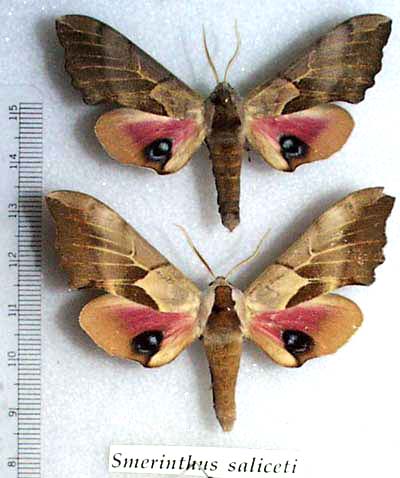
Smerinthus saliceti, male and female courtesy of Bruce Walsh.
ECLOSION, SCENTING AND MATING:
Adults do not feed.
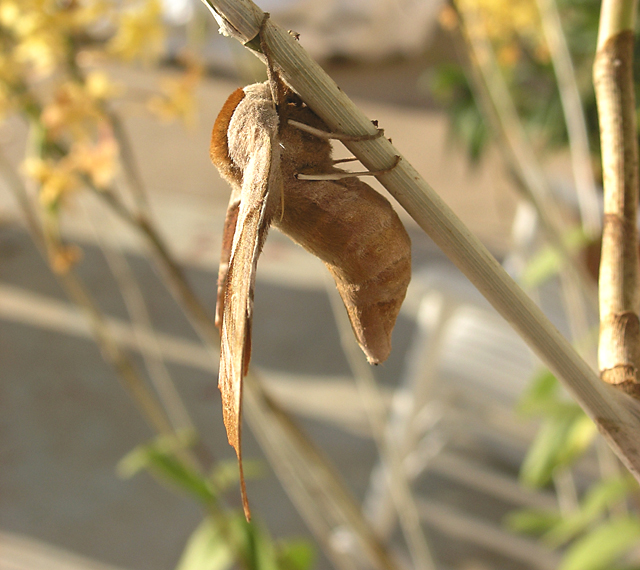
Smerinthus saliceti, Encinitas, northern/coastal San Diego County, California,
August 21, 2007, 5:00pm, courtesy of Don Doerfler, Digital Camera: Olympus 5060, 8MP
EGGS, LARVAE AND PUPAE:
There are two colour morphs, one a pale green and one lime green.Larvae feed on
willow (Salix) or poplar (Populus).
| 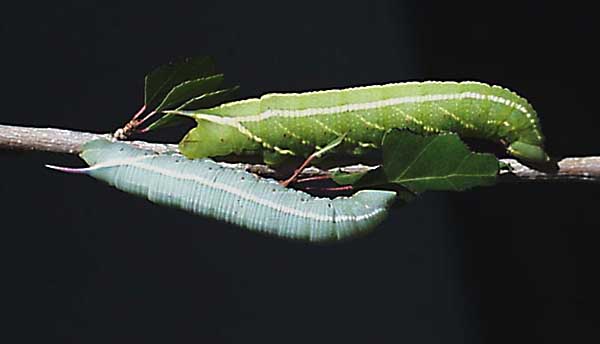 |
Larval Food Plants
Listed below are primary food plant(s) and alternate food plants. It is hoped that this alphabetical listing followed by the common name of the foodplant
will prove useful. The list is not exhaustive. Experimenting with closely related foodplants is worthwhile.
Populus.......
Salix
|
Poplar
Willow
|
Return to U. S. A. Table
Return to Main Sphingidae Index
Return to Smerinthini Tribe
Enjoy some of nature's wonderments, giant silk moth cocoons.
These cocoons are for sale winter and fall. Beautiful Saturniidae moths will emerge the following spring and summer.
Read Actias luna rearing article. Additional online help available.
Use your browser "Back" button to return to the previous page.
This page is brought to you by Bill Oehlke and the
WLSS. Pages are on space rented from Bizland. If you would like to become a "Patron of the Sphingidae Site", contact Bill.
Please send sightings/images to Bill. I will do my best to respond to requests for identification help.
 | 
Show appreciation for this site by clicking on flashing butterfly to the left.
The link will take you to a page with links to many insect sites. |








